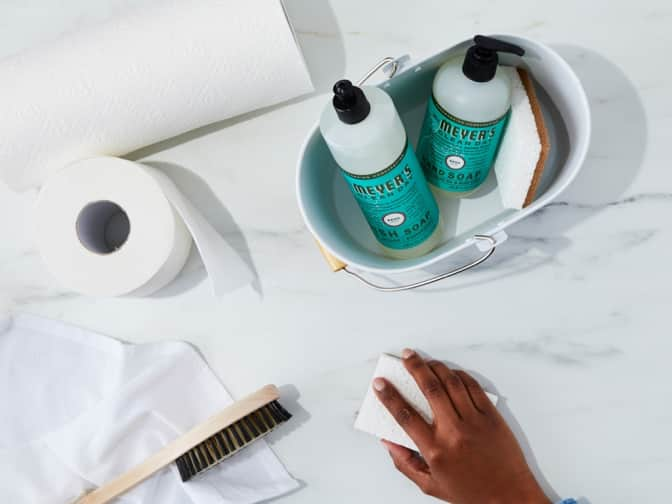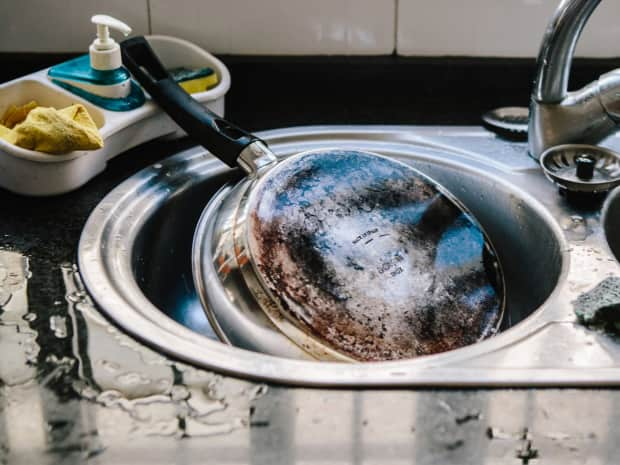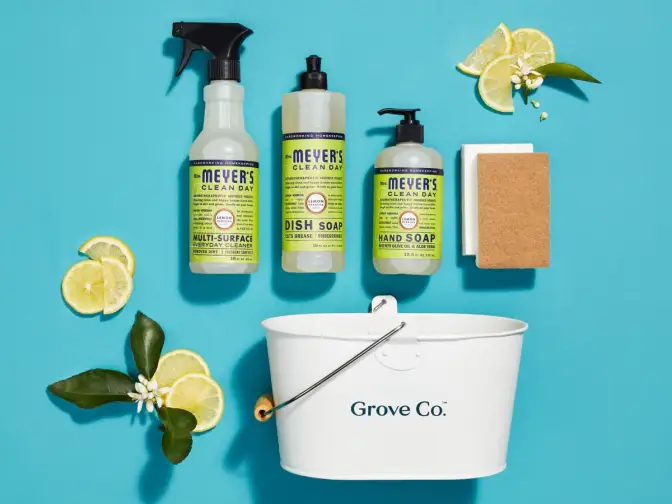
Sanitize vs. Disinfect vs. Clean: What’s the Difference?
How can you tell if you're using the right products to keep germs at bay? Learn about the difference between sanitizing and disinfecting from our team at Grove.
Read More


Last Updated: August 31, 2022
Looking to remove oil stains quickly and effectively? Follow our step-by-step guide to get oil stains off your clothes — and your mind.
There’s nothing more frustrating than oil and grease stains on clothing. It happens so innocently, too. A big bite of a juicy hamburger or hovering over a splattering pan without an apron — and suddenly you’ve got a mess.
Accidents happen, but that doesn’t mean you have to toss your favorite shirt. You’ve got to at least try to save it. Just follow our quick steps below for the best tips to help you remove stubborn oil and grease stains.
There’s no question, grease and oil leave behind some of the most stubborn stains on clothes. They can be difficult to clean out completely, although the sooner you attempt it, the better. Your success depends on the stain, the material and color of the fabric, and the way you try to clean it.
Though the stains may not look like much at first, they tend to darken the fabric over time as they set, which is why it’s important to work to remove them as soon as possible. The longer you wait, the more absorbed the oil and grease will become. Once it dries, the stain will be much harder to remove and may ruin your clothes beyond rescue.

If you use the right products and techniques, removing an oil stain becomes much more doable.
Try using a paper towel or napkin to blot out as much of the oil as possible as soon as you notice a stain. It will make it easier to clean out the stain completely once you start washing it. Try not to rub, as that will only push the grease deeper into the fabric fibers and make it less likely you’ll be successful at fully removing it.
Place the fabric on a flat surface and put a few drops of dish soap on the stain. Rub the fabric together with your hands or rub the soap in with a toothbrush to loosen the oil and grease.
In case of stubborn stains, sprinkle some baking soda on the stain, along with the dish soap, and then scrub with a toothbrush. Let it rest for a while until the baking soda dries slightly and covers the stain in a hard paste.
Once you’ve let the dish soap and baking soda work their magic — usually for about an hour — you can then rinse the fabric with hot water. Afterward, dip the cloth in hot water and leave it for another hour.
Once the stain is all but gone, wash the cloth in a washing machine in warm water and let it air dry. If the stain is not completely removed, repeat the steps once again.
While we’re not big fans of bleach due to its effects on the environment, we know sometimes stains require drastic measures. If the fabric is washed and dried, but is still stained, dip it in warm water mixed with color-safe bleach and let it sit for about an hour. Wash and dry as normal.
Grove Tip
The key is to clean it as soon as the fabric becomes stained. The longer you wait, the more absorbed the oil and grease will become. Once it dries, the stain will be much harder to remove and may ruin your clothes beyond rescue.
Liquid detergent, white vinegar, and warm water can perform quite the magic stunt on clothes stained with oil.
Oil is oil, whether it’s motor oil or cooking oil. Therefore, you remove it from clothes the same way: Try to blot out as much of the stain as possible, apply dish soap (and maybe some baking soda for tough stains like motor oil) and scrub with a toothbrush, rinse and soak in hot water, and then run through the washing machine.
You should approach oil stains on jeans like you would stains on any other piece of clothing, and since jeans are typically made from natural fibers, they tend to be more amenable to stain removal than clothing made from synthetic fibers. First, blot (don’t scrub!) the stain so it doesn’t settle into the fibers. If you’re out at, say, a restaurant and can’t remove your jeans, you can try using salt or artificial sweeteners on the stain to soak up the oil until you can give your jeans a deep clean at home using the dish soap and wash method.
Oils and greases are semi-solid at room temperature, meaning that it needs to be liquefied to be fully removed. The best way to liquify grease in fabric is to use warm or hot water when washing.
Dried oil stains are much more difficult to get out of clothing, but there are a few tricks you can try. First, you’ll need to attempt to return the oil stain to a liquid state by using hot water — or if that doesn’t work, adding a little more oil might help revive it. Most people have the best luck with WD-40, spraying it into a bowl and applying with cotton swabs, being careful to not let the oil stain through to the back of the clothing item. Then, soak up the stain using a few repeated brushings/scrubbings of baking soda, treat with dishwashing liquid, and wash and dry and usual. Side note: Never put an oil-stained garment in the dryer. The high heat will cause the oil to set and make it nearly impossible for stain removal.
They can be. The trick is to blot them quickly and treat them quickly. The longer you wait, the more likely they are to be permanent. Unfortunately, even after your best efforts at oil removal, you are sometimes left with a stain that’s there to stay. The fibers of your fabric may contribute to how stubborn your grease stains are. Synthetic fibers such as polyester are incredibly tough to clean because the oil and excess grease particles are attracted to them like white on rice. That means that without proper care and attention, stains like these could become permanent and result in throwing your favorite shirt to the trash pile.
Yep, white vinegar (also known as distilled vinegar) can be used solo as a degreaser. Simply cut with water (usually 1 part vinegar to 4 parts water) and apply to the grease. Usually, the vinegar smell will dissipate once the item is dry, especially if you run it through the wash. Always test in an inconspicuous area before applying to stains.
Here are the top three mistakes to avoid when dealing with an oil stain:
Remember, speed is the name of the game when getting oil out of clothes. Work fast and you should be able to remove an unsightly oil stain from your clothes easily. Good news for that favorite shirt!

How can you tell if you're using the right products to keep germs at bay? Learn about the difference between sanitizing and disinfecting from our team at Grove.

Need a quick refresher on how long those leftovers are safe to eat? Keep reading to learn more about the right ways to store leftovers and the best food storage options for food freshness and convenience.
Grove writer, Carly Reynolds, discovered three durable and sustainable food storage solutions that will help you minimize waste while maintaining convenience. But which one was her favorite?

Never Google “how to get burnt pans” again. Grove writer Mackenzie Sanford tried grab green Cookware and Bakeware Cleaning Pods on a few tough culinary messes, and she’s here to tell you all about it — with pictures!

Wondering who Grove is, what types of products we offer, and how to get a free gift set when you sign up? Learn more about flexible monthly shipments, customizing your shipment, and joining millions of happy households — no monthly fees or commitments required.